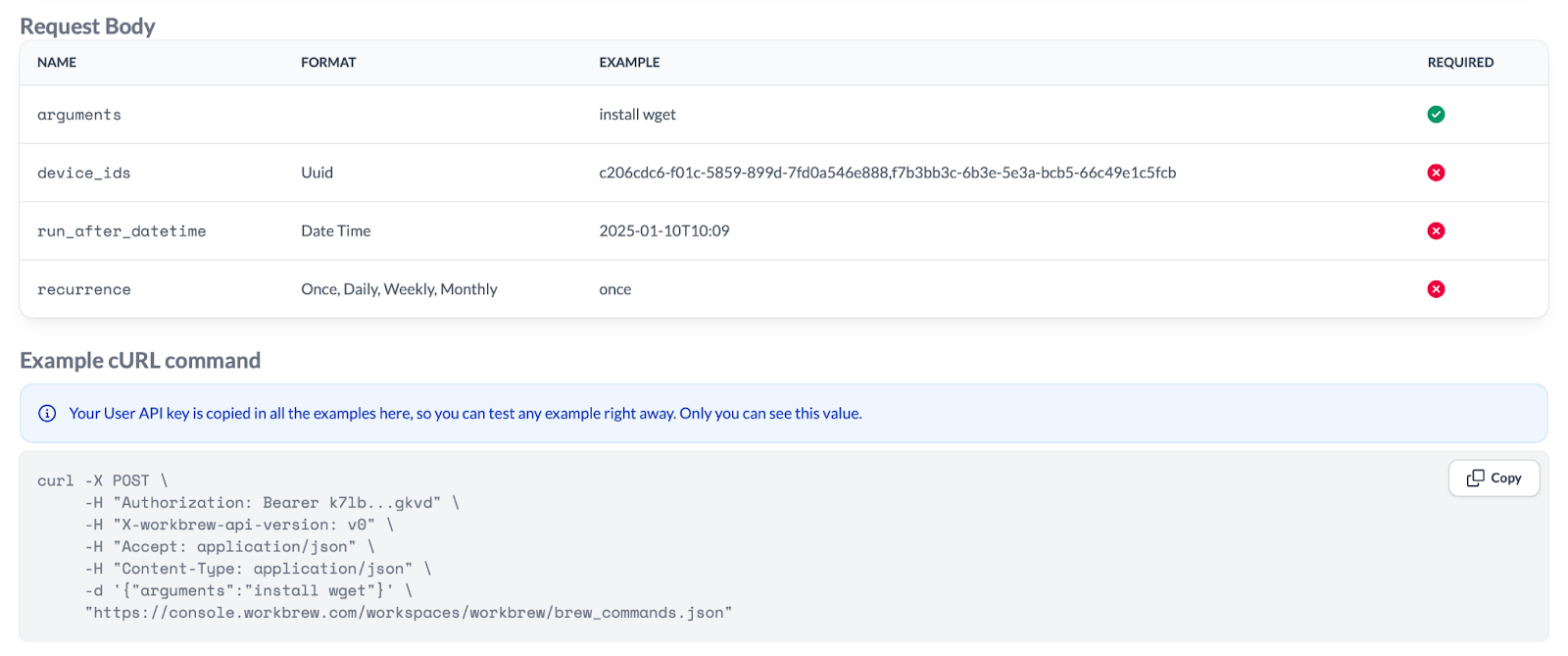
Creative Ways to Extend `brew` with the Workbrew API
Vanessa Gennarelli
Finding ways to connect internal systems, gain visibility across your fleet, and orchestrate complex workflows can be challenging — but Workbrew’s API offers building blocks to make it easier.
In a recent internal hackathon, we asked ourselves to show how the API can create meaningful, practical solutions for Workbrew users. The goal? To imagine new ways customers can extend, integrate, and enhance their Workbrew experience.
Operationally, our product engineering team uses the Shape Up methodology, which means product work happens in 6-week cycles with 2-week cooldowns. After shipping Workbrew 1.2, we used the cooldown period to run a “Hack Day” — giving team members a blank slate and 24 hours to experiment.
The projects they delivered showcased just how powerful the Workbrew API can be — and offer a glimpse of what you can build with it.
Project 1: Instant API Client Integration
Problem
Workbrew lacked ready-to-use Postman collections, making it harder for users to quickly integrate and experiment with the API. Leading platforms like Twilio and Stripe provide these assets, setting a clear customer expectation.

Process
- Imported our Swagger spec into Postman, Bruno, and Hoppscotch.
- Adjusted variables to support workspace names and default authentication.
- Explored CLI generation but identified limitations in OpenAPI 3.0 tooling.
User Impact
Workbrew users can now start experimenting with the API instantly through graphical clients like Postman — with no code, no CLI setup, and minimal configuration. Collections also unlock advanced workflows such as scheduled API tasks, lowering the barrier to adoption and increasing API accessibility.
Project 2: Natural Language Access to Workspace Health
Problem
Interacting with API endpoints can be technical and complex. We explored building a natural language interface for the Workbrew API to make data insights more accessible.
https://www.youtube.com/watch?v=g1ZXdvXxxhU
Process
-
Created a Custom GPT that interacts with Workbrew API endpoints.
-
Enabled basic querying of cached workspace data through natural language prompts.
User Impact
This prototype demonstrates how AI can simplify Workbrew data access, offering a future where users interact with their workspace health in everyday language — not complex queries. It's an early step toward making our platform even more intuitive.
Project 3: Improving API Documentation
Problem
Some API endpoints lacked clear examples, particularly around POST body formats for creating Brew Commands.
 Process
Process
-
Identified documentation gaps during internal review.
-
Collaborated across teams to validate and update API documentation.
User Impact
Clearer API documentation accelerates developer onboarding, reduces friction in integration, and strengthens user confidence when building on top of Workbrew.
What Can You Build with the Workbrew API?
Whether you’re an IT admin scaling systems, a developer automating workflows, or a security/ops team looking to connect Workbrew to the broader stack — the possibilities are endless.
The hackathon projects highlighted the true power of the API and how it can help your team:
-
What workflow can you make more efficient?
-
How can you integrate your tools to improve data flows?
-
What repetitive task can you eliminate?
The Workbrew API isn’t just a tool — it’s an invitation to create.
What’s Next
Many of the experiments from the hackathon are evolving into longer-term projects, with a focus on streamlining usability, expanding documentation, and delivering more intuitive customer experiences.
If you’re ready to explore what’s possible, watch CEO and Co-founder John Britton present Custom Integrations and Workflows with the Workbrew API.
See the API live in action and learn how it can help you build smarter, tailored solutions for your team and catch up with our Custom Integrations and Workflows with the Workbrew API webinar.
As we build on the momentum from this hackathon, we remain focused on delivering even more powerful, intuitive, and accessible experiences for every Workbrew user.